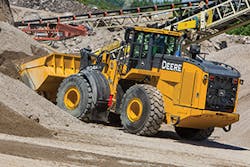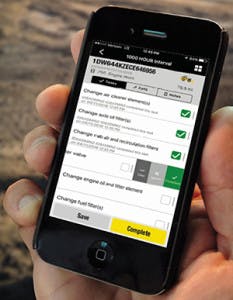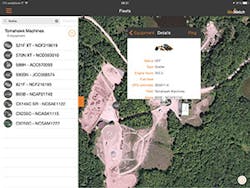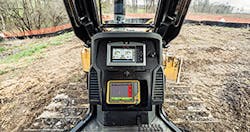While grading and excavating equipment continues to get better and better, the smart equipment, software, and systems that support this equipment and improve its safety, efficiency, and productivity are also getting better.
John Deere WorkSight
John Deere’s WorkSight is actually a family of five different technologies designed to do just about everything that machine owners and operators need.
The first technology is the JDLink Machine Monitoring System, which is WorkSight’s telematics tool. It helps owners locate their machines, enable security, and view machine utilization data. There are two versions of JDLink.
JDLink Ultimate provides information on the hours and locations of equipment. It also sends machine health alerts and tracks machine production.
“JDLink Ultimate comes in-base on our construction equipment, right out of the factory, and produces and transmits a lot of deep data about that machine’s duty cycle, how it is being used, what its fuel burn rate is, diagnostic trouble codes, PM alerts, and so on,” says Liz Quinn, product marketing manager for John Deere WorkSight.
JDLink Universal Telematics, is able to equip John Deere equipment and other assets with cost-effective devices, and then centrally manage all of these assets from one web application. “JDLink Universal is a lower cost field-kit solution that can be put on Deere and non-Deere assets,” says Quinn.
The second technology is Machine Health Prognostics. One feature is that it combines fluid analysis and JDLink data.
A second feature is that it provides advanced proprietary rules logic, which analyzes machines’ fluid sampling results along with JDLink data. Then, the condition-based rules-engine logic points to problems, measures how critical they are, and provides solutions to resolve them before downtime occurs.
“The condition-based rules-engine logic is a dealer intelligence tool called Expert Alert,” says Quinn. “It is a rules-engine that looks at the fluid samples that are coming in from the lab and making it easy to determine what action should be taken, such as changing out a fluid, changing out a filter, or even advising the operator how to operate the machine differently, such as not riding the brake as much, et cetera.”
Rules-engine also looks at telematic data, such as how hard the machine is being used, whether it is idling for a long time, etc.
A third feature of Machine Health Prognostics is that it provides machine health alerts and recommendations, which can be delivered to the customer and/or the dealer.
A fourth feature is that it evaluates machine data and “thinks through” maintenance protocols before prescribing downtime cures that will keep the customer’s fleet healthy.
The third technology is Remote Diagnostics and Programming. With this technology, dealers can remotely read and clear diagnostic codes, record machine performance data, and update software. The technology also eliminates the time that is associated with waiting for a dealer technician to arrive on the job site.
The fourth technology is Grade Control, which provides grading accuracy for motor graders, crawler dozers, and excavators, thus reducing passes and labor requirements, and leading to faster job completion. It comes in 2D and 3D.
The conventional 2D grade control system is suited for flat areas or slight grades. It uses solid sensors of a laser transmitter and sensor along with machine-position sensors to display the “cut and fill” requirements to maintain grade on a monitor. It also adjusts the blade for the operator.
The 3D system is best for complex contours. With the 3D grade control system, the customer’s job design elevations are entered into the crawler dozer’s or motor grader’s control box. A receiver on the machine reads the GPS signals received by an elevated antenna, as well as correctional data transmitted by a jobsite-based station, to calculate an accurate cutting-edge position. The control box’s computer compares the cutting edge position to the design elevations, and then displays “cut and fill” information. It also adjusts the blade for the operator.
“The 3D system is gaining more popularity as more and more contractors are working off 3D models, rather than two-dimensional paper models,” says Quinn.
The fifth technology is Payload Weighing. This monitors Deere’s articulated dump trucks (ADTs) and wheel loader payloads to provide overload protection, with mirror-mounted load indicators that inform the operator when the truck is nearing capacity. It also provides payload scales, which allow the operator to track total tonnage and cycles. It calculates the carryback after the load is dumped for accurate production values. It monitors trip counts. It provides a view of historical data for reference on similar jobs. Finally, it adjusts required margins in estimates, allowing the customer to become more competitive.
How are the five technologies used most often? Two technologies optimize Machines, three technologies optimize Uptime, and three technologies optimize job sites.
1. Machine Optimization: JDLink Telematics and Payload Weighing optimize machines. For example, they allow the customer to see the machines that are idling excessively (excessive fuel consumption), are inactive, are running at very high loads for long periods of time (to match machine size to job), or are moving when they should not be.
2. Uptime Optimization: JDLink Telematics, Machine Health Prognostics, and Remote Diagnostics and Programming optimize uptime. For example, these technologies provide maintenance assistance for fleets of any size, alerting the customer immediately when maintenance may be required (including customizable maintenance schedules), or when equipment issues may be arising that need immediate attention.
3. Job Site Optimization: JDLink Telematics, Grade Control, and Payload Weighing optimize job sites by helping customers make sure they get the right machines on the right job, and also allow customers to “watch over an operator’s shoulder” from miles away to ensure the most efficient operation.
Which of the five technologies is the most popular? It depends who you talk to, according to Quinn.
“My belief that you can’t effectively operate your equipment these days without a telematics tool, so equipment managers will tell you that they can’t live without JDLink,” she says. “However, managers on the job rely on grade control, which is used by the operators doing the work, so they would tell you they can’t live without Grade Control.”
Delivery OEM Data Delivery’s KeyPOD system
OEM Data Delivery
OEM Data Delivery offers telematics that provides information on things such as equipment location and hours. “However, we can also provide the customer with information on work versus idle hours, using our vibration sensor,” says Mick Lauer, CEM, project and account manager, Data Delivery Products and Services, for OEM Data Delivery. “This is helpful if you have an operator who likes to sit there running the air conditioning all day, but not getting any production done.”
The company has also recently introduced a technology called KeyPOD, which is designed to improve safety and risk management. “KeyPOD is operator-controlled, so only a certified or qualified operator can enter the correct code to get into the KeyPOD system,” says Lauer. “If the LED lights on the outside of the cab turn green, it means there is a certified and qualified operator operating the machine.”
CASE’s SiteWatch display
In addition, KeyPOD can activate the system such that, if someone else tries to operate the equipment, it won’t even start. “This is particularly useful for high-dollar pieces of equipment,” he says.
KeyPOD also provides a direct line of communication from the operator to the service manager, transforming daily paper inspections into electronic inspection reports. “With a paper inspection, it can take a month for daily and weekly inspection reports to get back into the hands of the service manager,” says Lauer. “In addition, the paper usually doesn’t even tell you if the equipment is even still operating.”
Now operators can electronically enter inspection information into the KeyPod. “This goes to our Web server, so we can send out e-mails or text messages to the service manager saying that the inspection is complete,” he says. “Or, if the equipment is down, we can send that message electronically to the service manager or, on a big project, to the onsite mechanic.”
To sum up, according to Lauer, if the project manager walks around the job site and sees nothing but green lights, it tells him or her that certified operators are operating the equipment, and that those pieces of equipment have passed their daily inspections that day.
“In terms of risk management, we are putting the daily inspection information back into the hands of the owner of that piece of equipment, which might be a company that rents equipment to customers for use on job sites,” he says.
This provides the owners with daily information on whether inspections are taking place properly, and if any incidents have occurred. According to Lauer, this can be helpful in court cases, where a user may claim that they have reported problems to the dealer, but there is no electronic record of the operator ever having made those reports on problems to the equipment owner.
Komatsu America Corp.
According to Sebastian Witkowski, product marketing manager, Intelligent Machine Controls, for Komatsu America Corp., before the introduction of machine control there was a higher learning curve for new operators to be able to work efficiently and accurately. Traditionally, skilled operators will “know how the dozer reacts to different loads and applications, and how the machine feels and responds to various situations and scenarios,” he says.
“It took a very skilled operator to efficiently get close to grade and finish grade,” he says. “Even then, it wasn’t uncommon for even skilled operators to have to go back and adjust elevation until they got to finished grade.”
Now, with Komatsu’s Intelligent Machine Control, operators have position information available at their fingertips in the cab, providing real-time information on accuracy. Today, with Intelligent Machine Control, the blade will automatically raise and lower in order to optimize blade load and minimize dozer track slip as it works toward the design surface.
“This means that operators of all experience levels to operate more efficiently and accurately from first to last pass,” says Witkowski.
The same is true for excavators, too. Operators can efficiently take full buckets, maximizing each pass, without worrying about going through design grade, meaning they don’t have to go back and fill in, or go back and dig further.
Komatsu also offers a support side, through its Technology Solutions Expert (TSE) network. These individuals are trained to support customers on their machines and technologies, as well as on related products, such as 3D modeling.
“This means that customers don’t have to talk to three or four different people,” says Witkowski. “The TSE can provide the answers to all of their questions. In addition, the TSEs can provide machine control usage reports of our Intelligent Machine Control machines.”
According to Witkowski, customers report efficiency and productivity gains. “Intelligent Machine Control provides as up to 66% reduction in construction time, when compared to conventional construction methods” he says.
Another technology service that Komatsu America offers to customers, according to Goran Zeravica, distributor operation development manager, is that the company’s dealers are now able to be consultants and work closely with customers. “For example, they have data on how often machines are idling, and can report to customers if a certain machine is idling quite a bit more than average,” he says.
In addition, the company’s dealers work closely with the TSEs. “In fact, the dealer and the TSE often attend customer meetings, allowing them to provide direct operator training,” says Zeravica.
The company’s technology also allows the machine to “talk” to the operator. “For example, it provides information on how determine how efficiently the machine is burning fuel,” says Zeravica. “This may provide the operator with the opportunity to switch from Power mode to Economy mode, which can provide 15% to 20% fuel savings.”
A Cat dozer equipped with Topcon’s 3D-MCMAX machine control system employing dual IMUs.
CASE Construction Equipment
One technology being offered by CASE Construction Equipment is SiteWatch, the company’s telematics solution that is designed to gather critical information about machine performance and location, and make that data quickly available to the customer. For example, it identifies excess idling to make sure working hours are productive hours, it operates health parameters, motion detection helps with theft prevention and recovery when maintenance is needed, and diagnostics helps with preparation before machine inspection.
“SiteWatch is an online user interface that supports machine tracking, as well as information coming across the machine, allowing customers, operators, and other end users to gain information about real-world applications without necessarily having to be right there in front of the machine,” says Brad Stemper, solutions marketing manager for CASE Construction Equipment.
“There is also a lot of knowledge on Sitewatch that dealers can use,” he says.
For example, since they have data on sometimes hundreds of machines, they can send information to customers on how their specific machines are operating, so customers can compare the operation of their machines to all of the other similar machines that other customers are using for which the dealer has data.
While CASE Construction Equipment doesn’t currently offer factory-integrated machine control, it does work with a partner that provides machine control solutions for the company. “Machine control technologies reduce the amount of manpower required on the job to measure and maintain information, thus improving efficiency and productivity,” says Stemper. “Besides working with a partner on machine controls, we also have an open architecture approach to some of our products, where we offer machine control readiness systems directly out of our plants, which allows owners to more easily equip their machines with machine controls.” This reduces the time required to perform installation and set-up from a day or two down to two or three hours.
InSite SiteWork Earthwork & Utility Estimating Software allows contractors to quickly take off excavation projects from PDF files and CAD files, with no need to print plans until a job is awarded. “This frees the estimator to work anyway,” says Steve Warfle, product manager. Vector selection from PDF files significantly reduces the time to input data, and advanced drawing tools allow incomplete designs and design-build projects to be completed with confidence.
“3D Live renders a clear view of the project in real time, providing validation of the data entered and proof that the take off is correct,” explains Warfle.
To be sure that maximum productivity and accurate results are achieved, each license sold comes with a five-course training program that starts with the basics and progresses to the advanced. “We find a lot of technology is under-utilized due to lack of training opportunities for the user,” says Tara O’Neill, lead instructor for InSite Software. “Our experienced instructors and weekly availability of online training, all without cost of travel, allow our customers to get the maximum value out of their investment.”
According to Kris Maas, director, Product Management Machine Control, for Topcon Positioning Group, Topcon has a mission to provide superior end-to-end solutions for the construction industry by integrating high-precision measurement technology, software, and data. Topcon’s new advanced dozer machine control system, 3D-MCMAXimproves productivity by using dual IMUs that provide high-accuracy elevation, slope, and blade rotation sensing to increase on-grade performance, while eliminating the need for a mast on the blade.
“It is designed to redefine the concept of machine control by providing high-accuracy elevation, slope, and blade rotation sensing in an integrated configuration, resulting in maximum speed, maximum control, and maximum grading performance,” says Maas.
The system uses Topcon 3D-MC2 technology with the dual IMU sensors and unique algorithms to deliver an integrated solution that locates the sensitive GNSS technology safety inside the cab, instead of out on the harsh environment of the blade. “Gone is the need for daily installation and removal of antenna, cables, and mast,” says Maas. With 3D-MCMAX, the operator simply climbs on and gets to work, minimizing downtime.
“The clean integration lets operators work confidently in rough or fine grade applications, slope conditions, and in restricted sight environments, without the visual obstruction of masts or risks to hanging cables,” says Maas.







